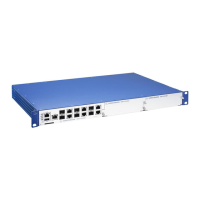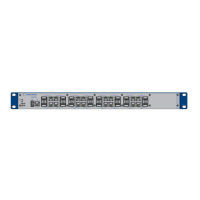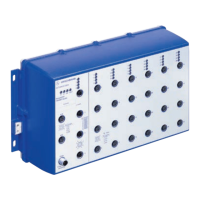Specifying the IP parameters
2.1
IP parameter basics
45
UM Config GRS
Release
8.0
09/2019
Lorenzo receives the letter, removes the outer envelope and recognizes from the inner envelope
that the letter is meant for Juliet. He places the inner envelope in a new outer envelope and
searches his address list (the ARP table) for Juliet's MAC address; he writes her MAC address on
the outer envelope as the destination address and his own MAC address as the source address.
He then places the entire data packet in the mail box.
Juliet receives the letter and removes the outer envelope. She finds the inner envelope with
Romeo's IP address. Opening the inner envelope and reading its contents corresponds to
transferring the message to the higher protocol layers of the ISO/OSI layer model.
Juliet would now like to send a reply to Romeo. She places her reply in an envelope with Romeo's
IP address as destination and her own IP address as source. But where is she to send the answer?
For she did not receive Romeo's MAC address. It was lost, because Lorenzo replaced the outer
envelope.
In the MIB, Juliet finds Lorenzo listed under the variable
hm
NetGatewayIPAddr
as a means of
communicating with Romeo. She therefore puts the envelope with the IP addresses in a further
envelope with Lorenzo's MAC destination address.
The letter now travels back to Romeo via Lorenzo, the same way the first letter traveled from
Romeo to Juliet.
2.1.3 Classless Inter-Domain Routing
Class C with a maximum of 254 addresses was too small, and class B with a maximum of
65534 addresses was too large for most users. Resulting in an ineffective usage of the available
class B addresses.
Class D contains reserved Multicast addresses. Class E is for experimental purposes. A non-
participating Gateway ignores experimental datagrams with these destination addresses.
Since 1993, RFC 1519 has been using Classless Inter-Domain Routing (CIDR) to provide a
solution. CIDR overcomes these class boundaries and supports classless address ranges.
With CIDR, you enter the number of bits that designate the IP address range. You represent the IP
address range in binary form and count the mask bits that designate the netmask. The mask bits
equal the number of bits used for the subnet in a given IP address range.
Example:
The term “supernetting” refers to combing a number of class C address ranges. Supernetting
enables you to subdivide class B address ranges to a fine degree.
IP address,
decimal
192.168.112.1
192.168.112.127
CIDR notation: 192.168.112.0/25
Mask bits
255.255.255.128 11000000 10101000 01110000 00000001
11000000 10101000 01110000 01111111
25 mask bits
Network mask,
decimal
IP address,
binary

